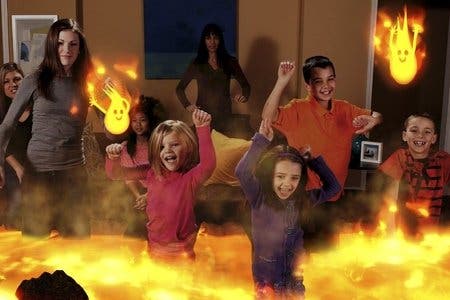Happy Action Theater Review
Show and tell.
"Daddy!" My daughter is standing in the doorway to my home office, arms crossed, her face bearing the sort of petulant look that only five-year-old girls can pull off. "You're missing all the fun!" Her message duly delivered she gives a haughty turn and runs back to the living room. That'll teach me to check my emails when Happy Action Theater is on.
If that sounds like an almost too perfect moment, the sort of thing an advertising executive would come up with, then imagine my surprise to be confronted with it, unscripted, in real life. Yet there it is. Natural, unrehearsed, honest passion. And this from a girl who has been, at best, ambivalent about gaming despite being raised in a house filled with consoles.
But that was before Happy Action Theater came along, bringing with it gameplay that she instinctively understood. That is to say, no gameplay at all.
"I love this!" she shrieks, throwing big gloopy blobs of lava at the sofa and reducing me, her beloved father, to ash in the process. Happy Action Theater isn't a game as we understand it, but that's probably for the best.
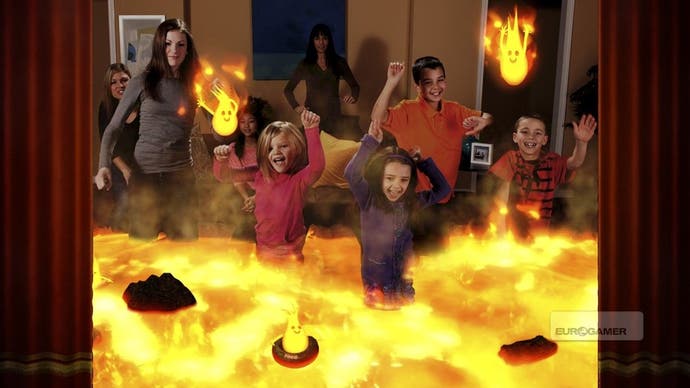
Watching my little girl completely absorbed by the simple interactive toys offered up by Double Fine in this chunky, cheerful package, I find myself realising just how boring and rigid and joyless we gamers can be. That's too casual. That's not hardcore enough. That's not a real game. That's been dumbed down. We, like so many hobbyist communities, seem to spend more time bickering and whining about what belongs in which box that we forget there's supposed to be fun and enjoyment in here somewhere as well.
Double Fine has bypassed all that. The closest Happy Action Theater comes to traditional gameplay is in a couple of activities where you shoot stuff at other stuff. Some of them even have scores. These, not coincidentally, are the ones my daughter tired of quickest.
For another child, however, they might well be a firm favourite and that's where Happy Action Theater (can we abbreviate it to HAT? That would be fun) shows its canny understanding of young minds. There are 18 toys to play with here, so if one doesn't appeal, it's quick and easy to move on to the next. Events are selected on a stage, or you can highlight the director and he'll serve up time-limited sessions in a random selection.
That's about as deep as the structure goes, but it's easy enough that even very young kids can navigate the game single-handed and the pull to keep exploring and trying new things is strong. Indeed, it's notable that of all the Kinect games I've played with my daughter, this is the first one where she's taken full control. Any attempt by me to make choices is firmly shut down. This is her game. I'm just lucky to be allowed in. Except when the game involves dancing. Then I'm ushered to the fringes of the screen, and eventually out of the room completely, so she can twirl around and see her actions transformed into a dizzying rainbow disco kaleidoscope on the telly.
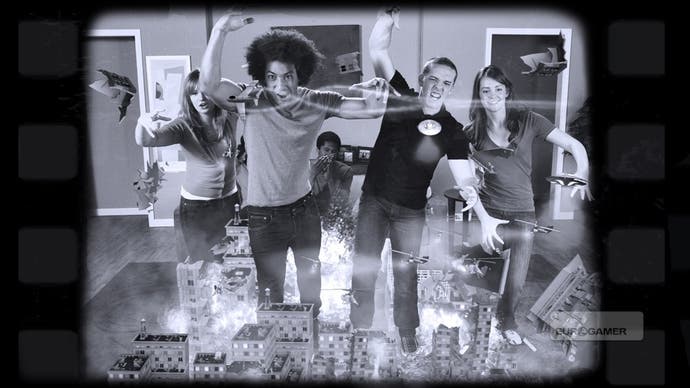
From my vantage point on the sidelines, it's admittedly hard to see what has her so enchanted. "Where's the game?" my brain keeps nagging, corrupted as it is by decades of high scores and difficulty levels and bonus missions and XP boosts. Some of the activities seem very thin indeed - one just puts you in a jelly and lets you wobble about - but others prove surprisingly deep. Or, at least, deep in a different sort of way.
The best bits are those where there's an initial frisson of excitement from the very concept. The lava one is an instant hit. Ditto for the one that fills the room with snow. The activity that casts the room in scratchy B-movie black and white and erects miniature skyscrapers all over the floor to be stomped on is charming even to my jaded eyes.
Where the brilliance seeps in is what happens as you mess about. Stand still in the snow game, for example, and you freeze solid. Move again and you explode out of your icy prison like a superhero. That alone leads to almost 20 minutes of hilarity, especially when we discover you can shatter each other. In another game, where you're at the bottom of a fishbowl grabbing at items dangled on hooks, the sudden arrival of a giant screen-filling Purple Tootfish prompts squeals of surprise. The initial rush of excitement at each new playground is compounded by these little moments of discovery.
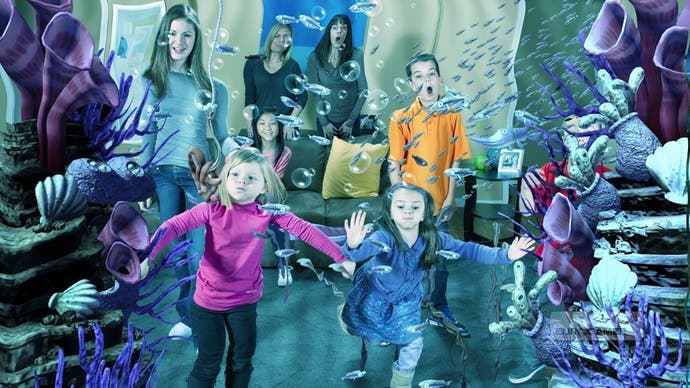
And while the games are simple in design, they're fiendishly clever in construction. Romping about in the snow, it's easy to miss how the drifts build up on the furniture, or how pigeons roost on real-world surfaces in a bird-feeding statue-standing game. Wonderful little touches abound. The city-smashing game is packed with details, from the little scaffolding and cranes that erect new skyscrapers to the gushes of water squirting out of the floor when you trample a tiny hydrant.
But still that voice nags away: "Is it a game?" The question, in the end, proves laughably redundant. Ask my daughter if she's playing a game and she'll look at you like you're an idiot (I get this look a lot) because of course she's playing a game. What else would you call it? The difference is, it's a game on her terms and, crucially, it's a game that takes place in her head, for the most part.
Games theory is full of talk about the ways in which the story unspooling on-screen in cut-scenes and voiceovers isn't necessarily the real story, which is what happens in your mind as you play. Most games - the games we adult players recognise and consider "real games" - are skewed towards the former, with its structure and rules and goals. Just like a child, Happy Action Theater tips the balance the other way and acknowledges that, at its purest level, play lives in the imagination.
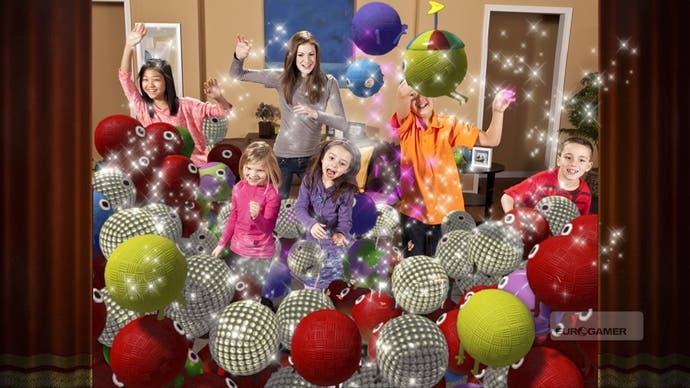
My daughter played Happy Action Theater for about three hours when we first downloaded it. We had to drag her away. She shows it off to her friends, who are equally enchanted by it. She now asks to play it after school rather than watch TV. The other day, I found she'd dragged a duvet into the middle of the floor and was making an igloo out of it. "Like in the snow game," she explained, as if talking to a slow-witted monkey that could only comprehend something if it had a leaderboard. Which, let's face it, she sort of was.
Kids are not dumb. They get this stuff far better than we do, as our creative arteries harden, choking on years of accumulated dogma about what games must be. We think we're gamers, but we've got nothing on kids. They understand. They know. It's what they do, all day, every day: make games in their head from the things around them.
That's what Happy Action Theater taps into, and it's a primal truth worth remembering. Games are made to be played - so why do we, the people who self-identify as gamers, have so much trouble accepting that play, pure and simple, can be a game?
